Define a Dragon
(And Other Tiny Foldy Books)

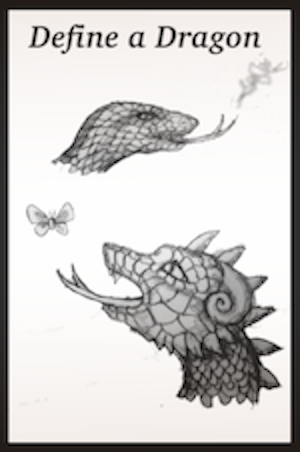
"Define a Dragon" is one of three Tiny Foldy Books that I hand out for free at conventions and other events. The first event where I handed out all three of them was CONvergence of 2017.
"Define a Dragon" is a book about dragons, fairies, wizards, definitions, and finding magic in everyday life.
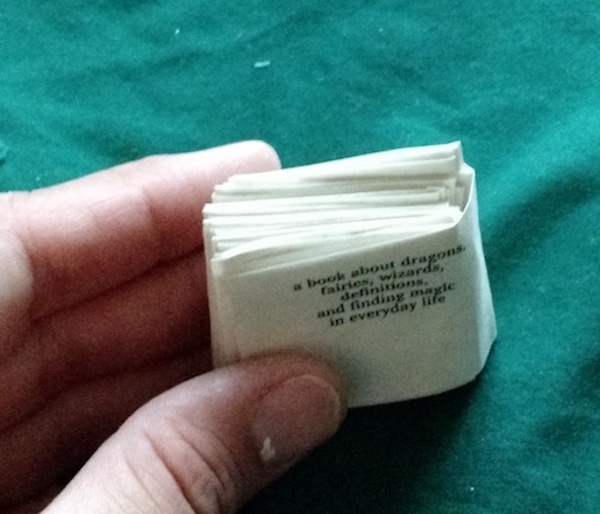
The other two Tiny Foldy Books are "Complicated Beauty" (the true tale of how and why I started making so many fancy sparkly things) and a tiny version of "Why the Muskie Has No Toes" (the gruesomely funny origin story of a Minnesota fish). All three are available for free download on this page.
Each Tiny Foldy Book is made from a single printed sheet of paper, cut and folded in a specific way.
To fold your own, here are the steps.
1. Print one of these pdfs.
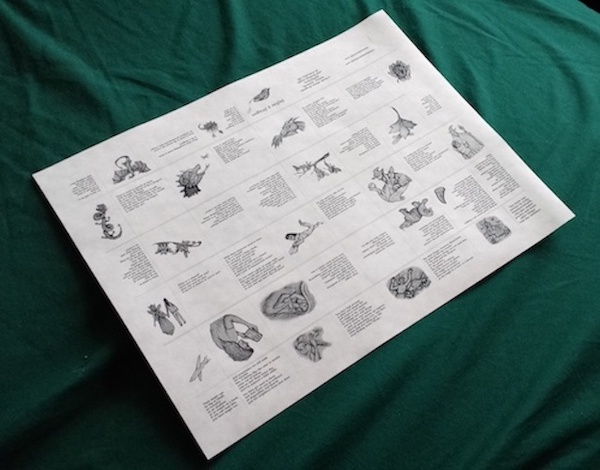
2. Cut on the thicker gray lines, as shown below. (Note that there is a half-inch blank margin, because most printers can't print all the way to the edge of the paper. When a line stops at the margin, treat it the same as if it went all the way to the edge.)
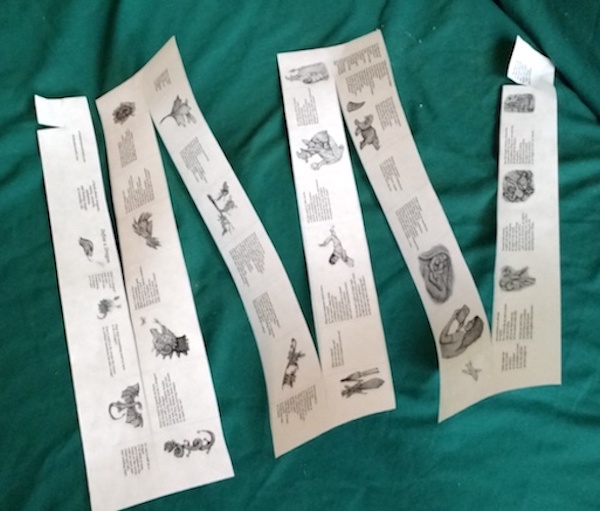
3. Fold on the thinner gray lines, accordion style, as shown in the pictures.
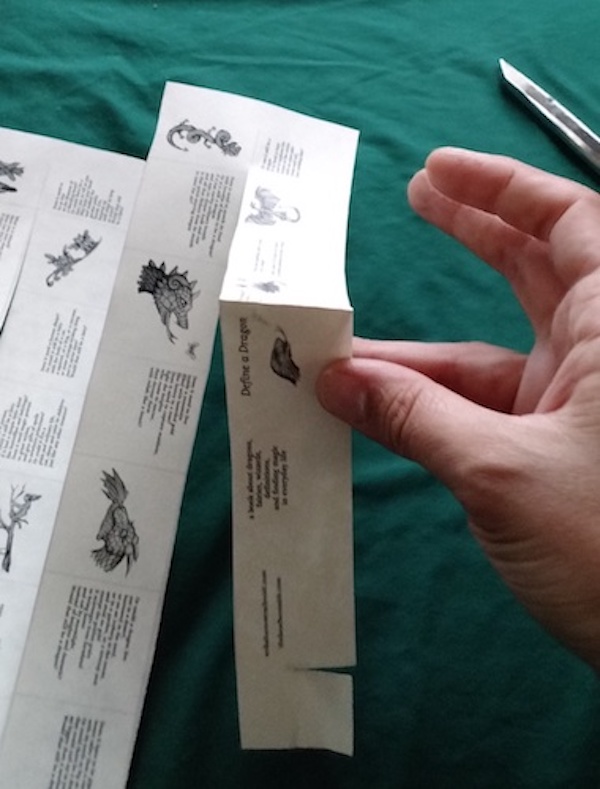
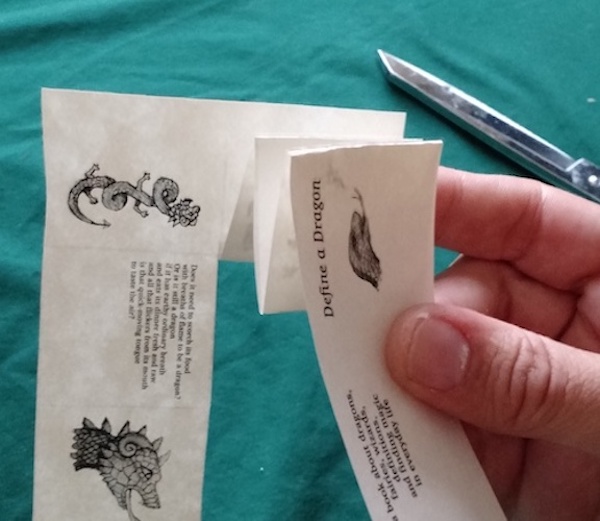
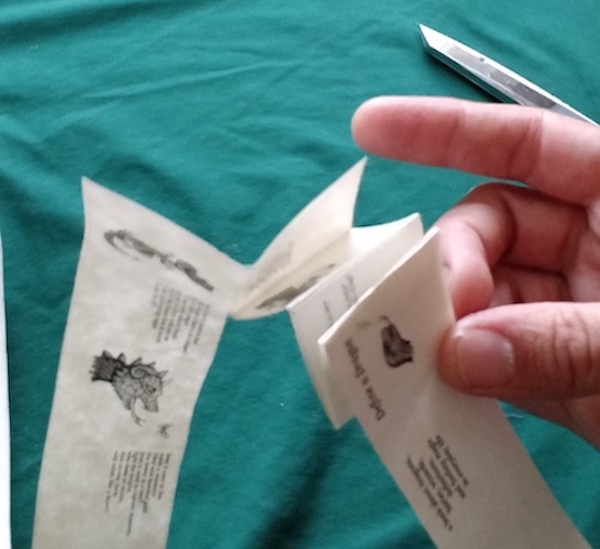
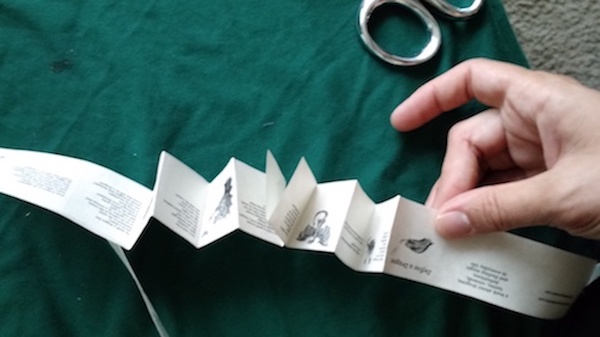
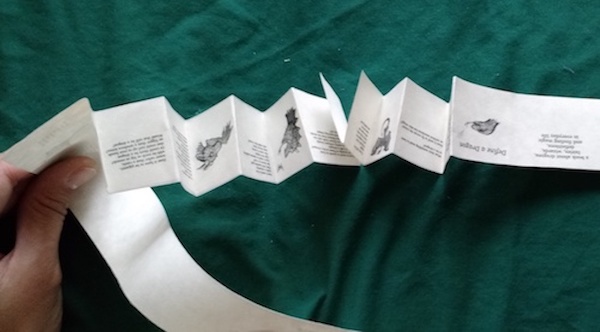
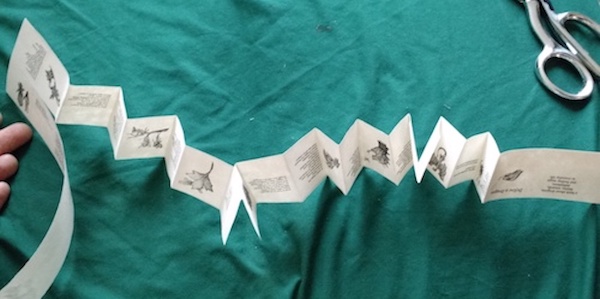
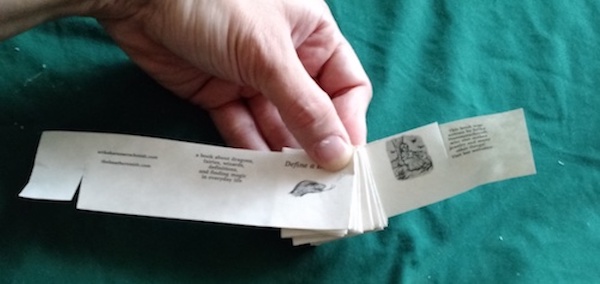
4. Secure the book with the notches.
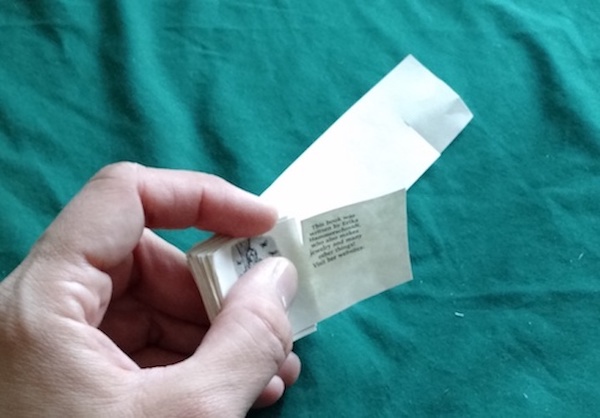
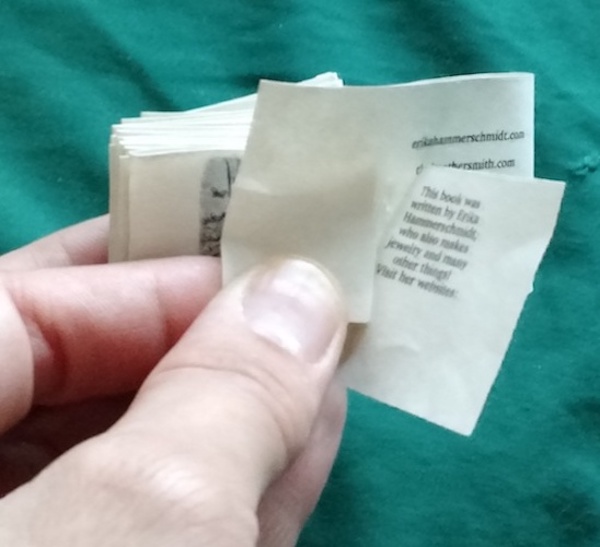
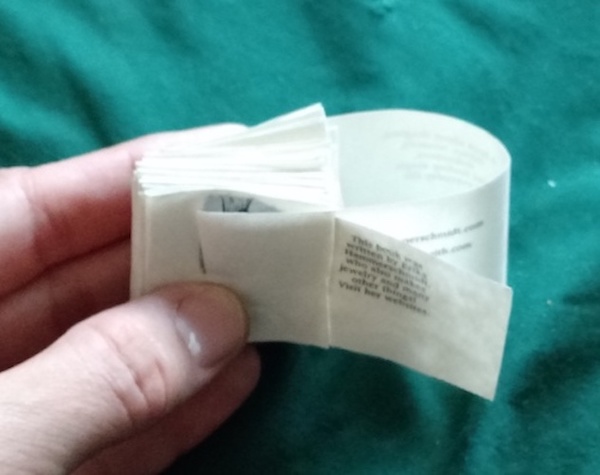
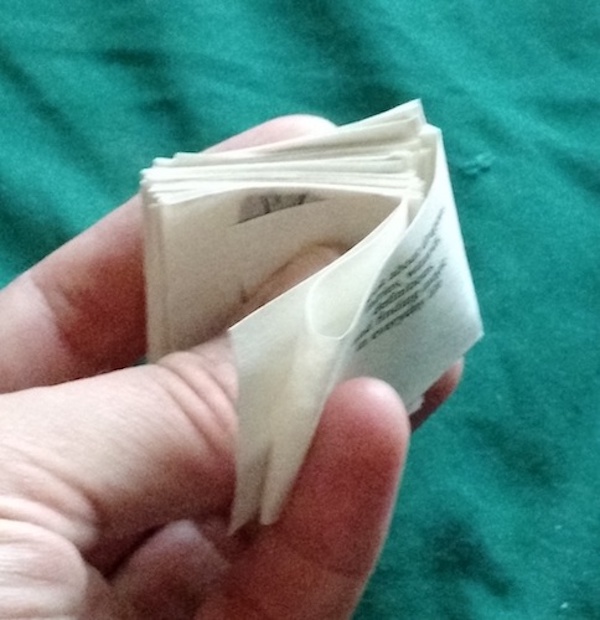

5. If desired, make it more secure by wrapping string around it in three places, then tying it tight (adding a bead if you want!)
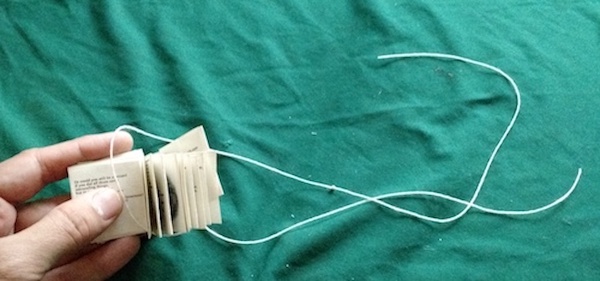
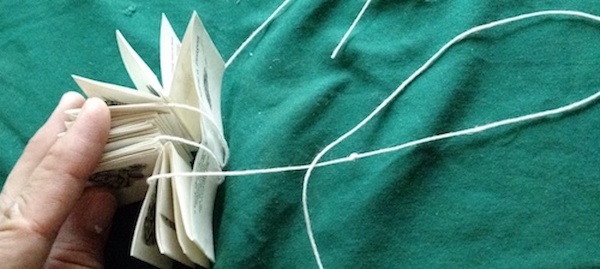
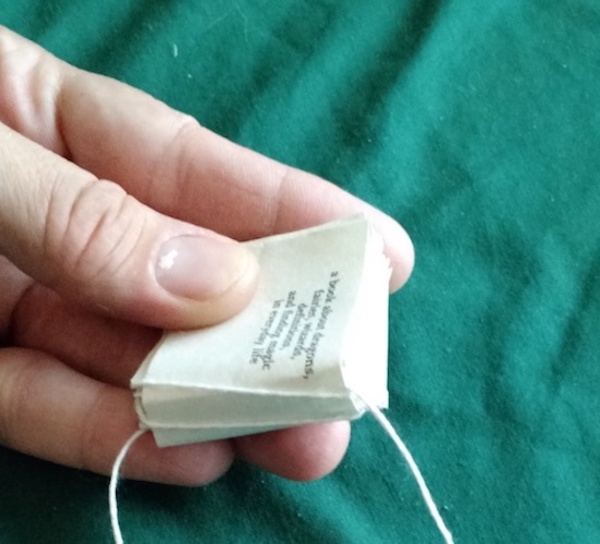
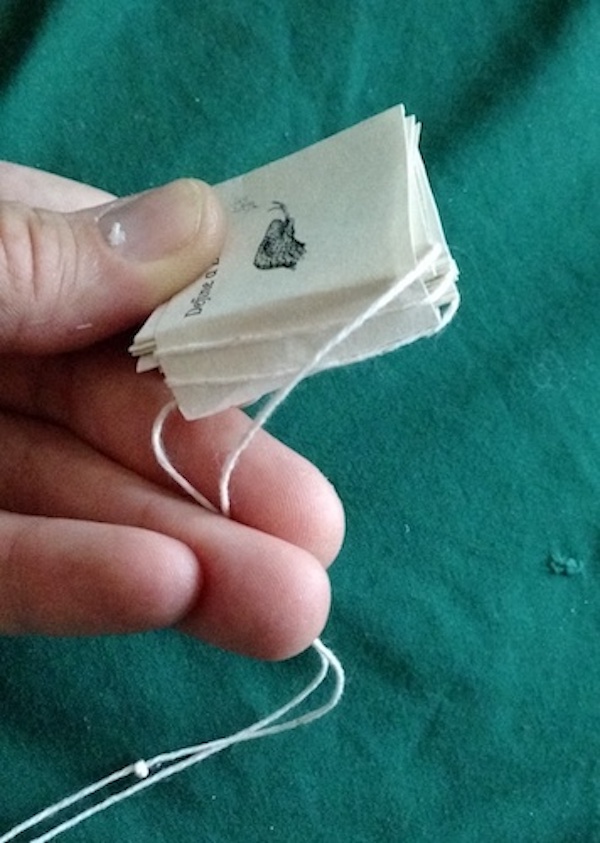
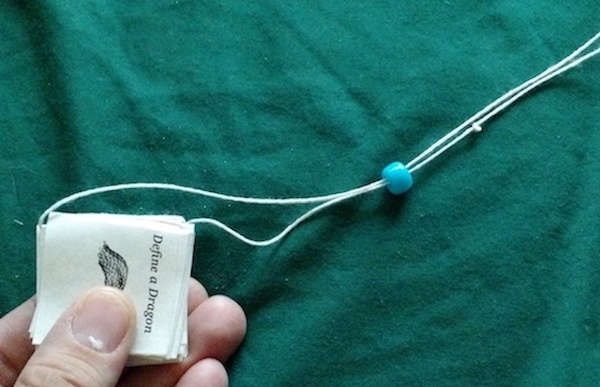
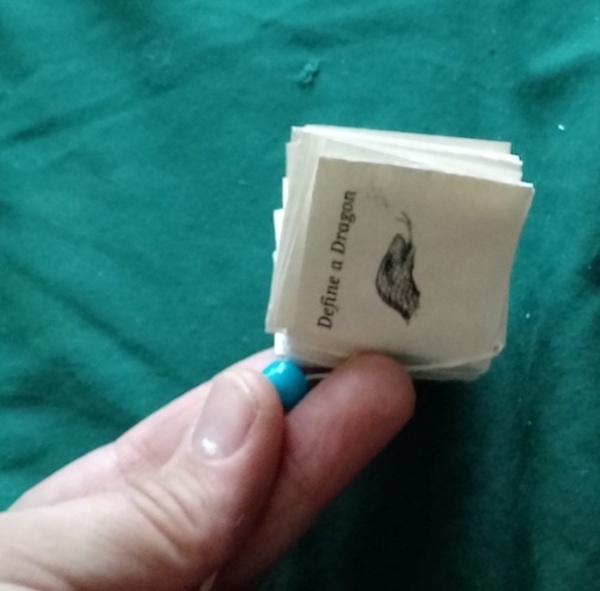
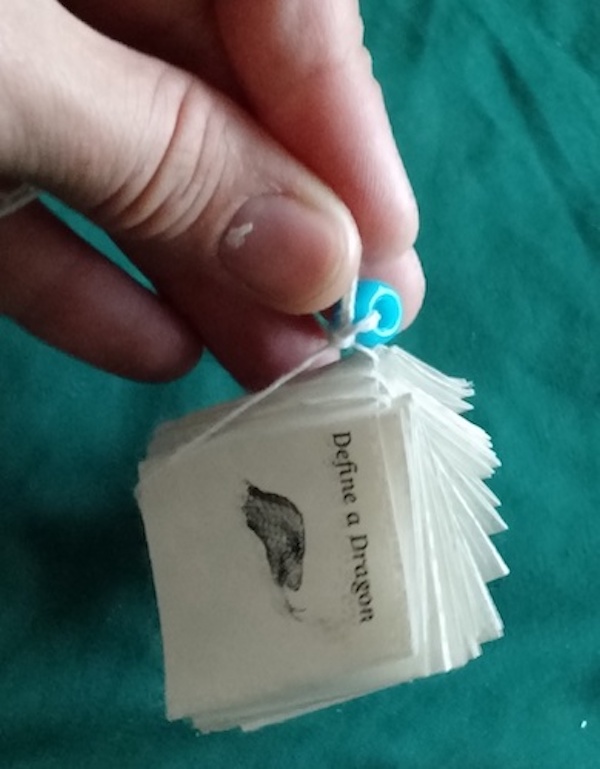
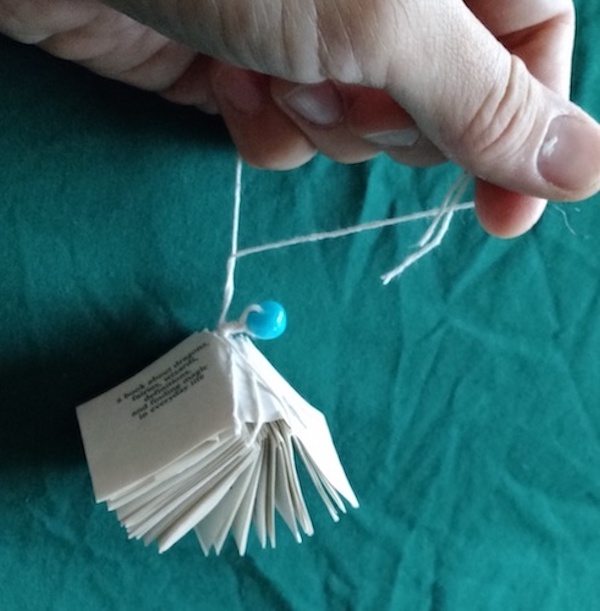
If you would like to design your own Tiny Foldy Book, here is a template!
Just edit the jpg with your own words and pictures, and then paste it into a word processing document with no header, no footer, and half-inch margins... then print.
Or, alternatively, print this pdf, and then write and draw your own book on it in pen, pencil, crayon or marker, however you want.
Below you will find the text of all three of my Tiny Foldy Books, just in case you want to know what's in them but can't read the pdfs. Enjoy!
________________
Define a Dragon:
________________
What is a dragon?
Have you ever seen one?
How can you be sure
if something is a dragon or it's not?
What does something need to have
to be a dragon?
Does it need to fly across the sunset
on webbed enormous bat-skin wings?
Or can it still be a dragon
if its back is bare
and it explores the forest or the ocean
with its maw and claws and tail,
and nothing else?
Does it need to scorch its food
with breaths of flame to be a dragon?
Or is it still a dragon
if it has earthy ordinary breath
and eats its dinner fresh and raw
and all that flickers from its mouth
is that quick-moving tongue to taste the air?
Does it need to live inside a mountain
filled with hoarded gold like honey in a tree?
Does it need to capture maidens,
fight the knights who come to rescue,
then devour them with relish like a beast?
Or could a dragon live
out in a desert, burrowed in the sand,
or on an iceberg in the ocean,
or in a garden, or a treetop nest
and steal no gold except the golden grain
it scavenges from farmland
to bring home and eat by moonlight,
instead of knights and damsels?
Would that still be a dragon?
Does it have to be gigantic,
tower taller than a castle,
with its teeth as big as swords?
Or could there be a dragon
that could curl up in your hands
no bigger than a newborn kitten?
Would that still be a dragon?
What is a fairy?
Have you ever seen one?
How can you be sure
if something is a fairy or it's not?
What does something need to have
to be a fairy?
Does it need clear and iridescent wings?
Or could there be a wingless fairy
that climbed the poppy-stems
to see across the field
and swung from spider-webs to play at flight?
Does it need to be as clever as a person,
or could it still be a fairy
if it had a simple little mind
like butterflies and ladybugs?
Does it need magic powers
to grant wishes, and give gifts of spells
to newborn princesses?
Or could it live a plain and ordinary life,
eat, sleep and raise its children
just like any other creature?
Does it need a human shape?
Or could it still be a fairy
with the body of a cat,
a squirrel, or a frog, or a raccoon,
or some strange-looking thing
you've never seen?
Would that still be a fairy?
Does it need to be as tiny
as the blossom of a bleeding-heart?
Or could there be a fairy just as tall as you
Who held your hand
and walked the garden paths beside you,
keeping up, with steps as long as yours?
Would that still be a fairy?
What is a wizard?
Have you ever seen one?
How can you be sure
if you're a wizard or you're not?
What does someone need to have
to be a wizard?
Do you need a dusty cloak,
a wrinkled, pointed hat,
a wand of ancient oak inlaid with gems?
Or could you still be a wizard
In faded jeans, a sweater
and a pair of mismatched socks?
Do you need a glow of magic light
that you can call forth from your wand
to light the way in darkness?
Do you need a crystal gazing ball
to scry and spy into a far-off place?
Do you need to ride across
a field of clouds
astride a knotted wooden
straw-thatched broom,
or write an incantation
with an ancient quill on parchment
that enchants your thoughts
and sends them off in secret
to another person's mind?
Or could you still be a wizard
if you did all those same
astounding things,
but in your own way,
using only ordinary pieces
of the ordinary world,
enchanted only with your cleverness?
Would you still be a wizard?
You might never see those magic fairies
with the forms of tiny people
and the crystal wings of flies,
But nature's fairies
are flying all around us,
the Hummingbird,
the Dragonfly and Butterfly,
the narrow-waisted Wasp,
the chubby Beetle, lifting up its shells
and spreading into flight.
Perhaps you'll never see a dragon
with leather wings and burning breath,
But nature's dragons show themselves
in many forms:
the Garter Snake, the Boa,
the Iguana and Komodo Dragon,
regal with their long and whiplike tails,
the Bearded Dragon
with its mane of spines,
the bones and teeth
of ancient giant dragons
like the Spinosaurus and the Mosasaur.
The mermaid and the unicorn
Are real, though very rare.
They just don't look
the way they do in books...
they're plump and gray
and go by other names:
Rhinoceros and Manatee.
Witches, sorcerers
and wizards and enchanters
are among us,
but they don't wear cloaks
or pointed hats
(unless they feel like it).
Their magic
is in tools and in machines,
and they can fly,
make light from darkness,
send their thoughts
from one mind to another
using only pen and paper,
and they can see what's happening
a thousand miles away,
then travel there within a day.
Their magic can be big or small,
as complex as an airplane
or as simple as a book.
If you can read this, you have magic too.
And sometimes
we still wish for wonder.
But, if fairies
like the ones in stories
came out of hiding
and we saw them every day,
we'd be amazed a little while,
but then get used to them
and find them just as ordinary
as dragonflies and lizards
and the neighbors from next door.
You may look around
at plain and simple life
and yearn to feel amazed
by magic in the world,
by strange and wild things
you've never seen before
...and, yes,
by all means,
go explore,
discover something new, and then,
when that new thing gets old,
keep finding newer things...
But don't forget, between discoveries,
to learn to feel the wonder
of the ordinary things
you see each day,
the fairies and the dragons
in the garden,
the miracle of writing,
and the sorcery of speech,
the magic everywhere
that's just as wondrous
as the magic in a story or a dream.
________________
Complicated Beauty:
________________
My sense of beauty loves complex things made of many small parts.
Many-blossomed flowers,
wind-up watches,
fancy jewelry,
detailed stories.
They are all beautiful to me.
This has always been true, even though complex things have also caused some of my worst problems.
Like my problems with people.
The rules to follow if you want to fit in...
they are so complex that people can't even really explain them.
People tried to teach me the rules. Every rule they stated was too simple, leaving out all the exceptions and conditions...
expecting me to fill in the blanks with instinct that I didn't have.
And it was never enough. I kept having to guess.
Guessing about where the rules might have an exception, guessing wrong, breaking them...
hurting others,
hurting myself.
The doctors said "Tourette Syndrome" and "OCD," then later "Asperger Syndrome." The rules of diagnosing are another complex system, with so many parts to break.
It isn't perfect at putting people in boxes, because people are even more complex. But it got me help that I needed, and I guess that's what matters.
There was never one single thing that changed my life all at once. Learning how to live in this world was a flower with dozens of tiny petals...
a watch built of hundreds of tiny pieces...
a necklace made of thousands of tiny jewels...
a journey of millions of tiny steps.
A complex thing, and a beautiful one.
I learned to make things that are beautiful in the way I love. I taught myself to make complex, fanciful jeweled necklaces and earrings and crowns.
I taught myself to write stories of vast futures and complex alien worlds.
And they were beautiful to me.
Because even though complex things are so hard to create, they are so satisfying when they're done.
Because the world, and nature, and people...
are all made of millions of tiny parts,
like the petals of a flower,
or the gears of a watch,
or the jewels of a necklace.
Full of complicated beauty.
________________
Why the Muskie Has No Toes:
________________
Why The Muskie Has No Toes By Erika Hammerschmidt
The muskellunge, who is also called the muskie, is one of the most powerful fish in the lakes of Minnesota.
It has a wide tail fin that paddles back and forth to propel it forward.
It has a sharp fin on its back that slices through the water.
And it has two strong front fins that steer it in whatever direction it wants to go.
But the muskie was not always such a grand fish. In fact, it once had to live on the lake bottom, eating the garbage that fell from other fishes' meals.
This was because in those days, the muskie had no wide tail fin, sharp back fin, or strong front fins. It just had six legs.
It had two front legs near its jaw... those were for picking up garbage and putting it in the big toothy mouth.
It had two legs sticking out in back... those were for kicking and scratching the strong fast fish that might sneak up behind the lowly muskie.
And it had two long legs that joined its body near the backbone... those were just for walking.
On the end of each leg were five toes. These toes were truly unlucky.
When the muskellunge ate, the toes had to pick up garbage out of the mud and put it in the big toothy mouth.
When strong fast fish sneaked up behind the muskellunge, the toes had to kick and scratch them, and sometimes get bitten.
And when the muskellunge walked, the toes had to squish through the mud of the lake bottom, holding up the weight of the rest of the muskie's body.
The muskellunge was the lowest fish in the lakes of Minnesota, and the toes were the lowest part of the muskellunge.
So one night, the toes decided that they would not put up with their sad situation any more.
"We are tired of being the lowest part of the lowest fish in the lake," they said. "We want a better life. And we refuse to work until we get it."
The next morning, when the muskie woke up, its toes wouldn't move! They hung limply from all six legs, doing nothing at all. No matter how hard the muskie tried to use them, they would not be used.
That day, when the muskie ate, it had to pick up garbage out of the mud with its mouth, and it couldn't help eating some mud along with its meal.
When strong fast fish sneaked up behind, the muskie had to turn around as quickly as it could, and scare them away with its teeth... sometimes it got bitten in the face.
And when the muskie walked, it had to walk on its heels, with the toes flopping uselessly around.
At the end of the day, the muskie was fed up. It felt sick from eating mud, it had bites on its face, and its heels ached from walking.
"I must do something!" it moaned. "I can't stand living like this much longer!"
So the muskellunge called upon the King of the Minnesota Lakes.
He appeared in all his glory, with the tail of a fish and the body of a Minnesota fisherman, carrying a magical wand shaped like a fishing net on a long handle.
"Why have you summoned me?" he demanded of the muskellunge.
The muskie told its sad story. "My toes will not work," it lamented, "and I am sick from eating mud with my food, and strong fast fish have bitten my face, and my heels hurt from holding me up. Can you do something to help me?"
The King of the Minnesota Lakes thought for a good long time, and finally said, "I cannot make your toes work, poor muskie. But I can make them go away, and perhaps you will be better off without them."
And he waved his magical fishing net, and all of a sudden the legs of the muskellunge had no toes at all! The toes were lying on the ground nearby, twitching around in the mud.
And in a gigantic cloud of bubbles, the King was gone.
The muskie lay on the lake bottom, disappointed. It could see no way that losing its toes might help!
It still could not pick up food, it still could not kick and scratch fish that sneaked up behind it, and it still could not walk comfortably.
The insides of its legs drained out into the mud. Small fish nibbled at pieces of them, and water washed other pieces away.
In a few hours the muskie had no legs at all. It only had bits of skin dangling near its jaw, and sticking out behind it, and hanging from its back.
But the muskie soon found that the King was right.
When it paddled its rear end back and forth, the pieces of skin back there worked as a tail fin, propelling it forward.
When it began to swim, the bit of skin on its back stood up sharply, slicing through the water.
And when it wanted to turn a corner, the skin hanging near its jaw made a nice set of front fins, steering it in whatever direction it wanted to go.
The muskie had become one of the most powerful fish in the Minnesota lakes!
It no longer had to walk through the mud.
It could swim fast enough to catch its own food, and did not need to eat garbage from the lake bottom.
And it was now so strong and fast that no other fish dared to sneak up behind it.
The toes, however, were unhappy.
Lying on the lake bottom, they were more miserable than when they had been the lowest part of the lowest fish in the lake.
They could not move by themselves, without a muskie to control them.
They could not swim around, or even catch their own food.
And their insides drained out, and water washed pieces of them away, and small fish nibbled on other pieces.
Soon they were almost nothing but empty toe- skins.
So they, too, called upon the King of the Minnesota Lakes.
He came to them, swishing his fish-tail and waving his magical net-wand. "Why have you summoned me?" he cried.
"We have lost our muskie," they moaned. "We cannot move by ourselves, and we cannot catch our own food, and we have no insides. What will become of us?"
The King thought a good long while, and said at last, "I cannot bring you back to your muskie. But I can let you leave the Minnesota lake, and perhaps that will make your life better."
And he waved his magical net, and the toes began to change!
Suddenly they had eyes! And wings!
And legs of their own!
And they flew out of the water to find a new life to live.
From then on, the toes were happy. They flew around near the Minnesota lakes, and got to know all sorts of animals that lived on land.
Unfortunately, they still had no insides of their own. In order to stay full, they had to eat the insides of other creatures.
They never ate enough to hurt the other creatures badly, only enough to fill their own tiny bodies.
And that is why, sometimes, when you are near a Minnesota lake, you may be bitten by a muskie-toe.


!!! Latest News !!!









